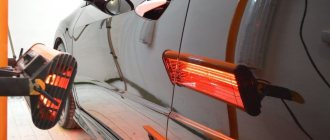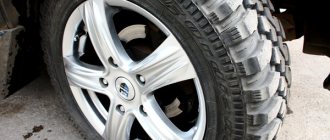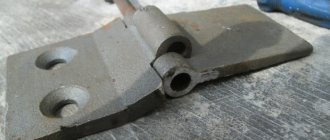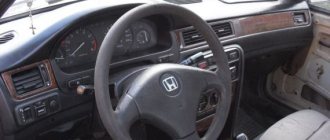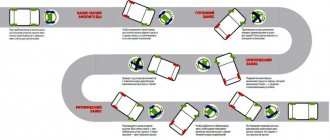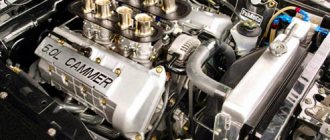Having shelled out a tidy sum of money for painting a car, the driver, of course, wants the paint to last on the surface of the body as long as possible. And here a reasonable question arises: how long after painting can you wash your car so as not to spoil the paint layer? After all, premature washing of a freshly painted car can lead to clouding of the surface and other unpleasant consequences.
Painting a car with a spray gun.
How long does it take for a car to dry after painting?
During the drying of the newly applied paintwork, the process of polymerization of the paint components, or their crystallization, occurs. The crystallization period may vary and completely depends on the type of paint, application conditions and operation of the machine. Typically, acrylic enamels dry faster than others (2-3 days).
There are paints and varnishes whose crystallization time is significant - up to 14-28 days, and only during this period do they gain full strength. You also need to take into account the drying time of the varnish, which can also be quite long. In any case, you need to find out about the exact drying time from a car painter or, if you did the painting yourself, read the instructions on the paint packaging.
Infrared drying of a car after painting
How long after painting can you drive?
Premature use of the car can cause clouding of the fresh coat of paint and varnish, the appearance of stains and small scratches. This will ultimately reduce the service life of the machine, because rust can “settle” in defective areas. The appearance of the coating will also suffer, and the aesthetic qualities will be seriously reduced.
The ideal option is to wait 14-20 days after painting the car, and only then start driving it. In practice, this is most often impossible, so it is recommended not to operate the car for at least 3-7 days from the moment of painting, and then drive it as carefully as possible, following the recommendations of professionals and protecting it from any unfavorable factors.
Drying
Answer the important question: “How long does it take for a car to dry?” a couple of phrases are difficult. Much depends on the size of the applied layer, the type of dye, and weather conditions. Often varnish is also applied to the paint layer. But the general answer is the longer the better! This answer also applies to the question: “When can I start washing my car after painting?”
The best answer to the question: “how long does it take for paint to dry on a car” will be given by the instructions for use, which are on each certified paint. Even the most experienced masters will not give an exact answer. And painting at the factory during serial production occurs according to the factory method.
How long before you can wash your car?
Washing a freshly painted car is strictly prohibited! However, when the car body becomes dirty, particles of dirt, dust, oils, and chemicals react with the paint, which has not yet gone through the stage of complete polymerization. Dirt seems to eat into the coating, scratch and spoil it, so a dirty car still needs washing.
Experts advise not to wash your car for a month after painting, if possible. Do not use high-pressure washing during this period, otherwise the coating may be damaged.
The minimum period of time during which washing is prohibited is 15 days, and even after this period, you should contact specialists for a delicate wash and do not scrub the body yourself. If the painting was done in winter, which does not happen often, you should not wash the body for as long as possible. It is better to find out about the exact period after which you can start washing from a car painter or read the instructions for the paint.
Prohibitions when washing a car after painting
In order for the operation of a new car paintwork to be long and problem-free, after painting you need to eliminate some actions and follow the advice of car experts:
- do not wash the car immediately after driving on a hot, sunny day, but first wait until the coating has cooled naturally;
- do not wash directly in the sun, work only in the shade;
- do not wash the car in the wind, do not allow debris or dust to get on the fresh paintwork, so as not to scratch it;
- do not place the car on gravel or sand surfaces, or place it on the grass while washing;
- do not use brushes, old sponges, other rough devices, as well as silicone or other scrapers to wash the body;
- do not use household detergents, especially powder ones;
- do not use cheap car shampoos of unknown brands, which can cause clouding of the paintwork;
- Do not use hard water for washing, which leaves white spots and stains - they will have to be scrubbed off, and this is harmful to the paint.
Gentle washing of the car should be carried out at least 3 times after painting. Only in subsequent washes can you follow the general recommendations for washing the body.
Dyeing process
Before the self-painting procedure, pay attention to the preparation of the body:
- the surface must be degreased and sanded;
- then apply primer and wait for it to dry;
- sand the primer layer with sandpaper;
To avoid paint getting in, glue the paper
- glue the part so as not to stain adjacent elements;
- degrease the surface again and check it for unevenness and defects;
- Before the procedure, put on a special suit.
- purchasing special shampoos that contain wax, or products with silicone;
- choosing a suitable place and time;
- use of special equipment.
It is recommended to perform 2-3 procedures after coloring only with water. For the first wash it is important:
The car must be thoroughly wetted manually with low pressure of water (medium temperature water is used for washing cars). Apply shampoo with wax, which was previously diluted in water. Wash surfaces with a soft sponge. Wash the car from top to bottom, and you also need to wash and rinse one side first, and then the other, to avoid the detergent drying out. To rinse the sponge (new!) use running water. Then the car is watered generously with clean water. The washed car is left to dry.
To prevent damage to the paintwork, you must follow these recommendations:
- Try to use only good detergents from well-known manufacturers (each surface has its own).
- Before washing, leave the car in the shade or indoors to allow it to cool, which will prevent further clouding of the varnish.
- Choose a windless location to avoid dust that will scratch the varnish. In addition, due to faster drying in the wind, whitish streaks may appear.
- Avoid exposure to directed sunlight, which can turn drops into lenses that burn through the coating. Cloudy, windless weather is ideal.
- During operation, protect the vehicle from exposure to harmful factors, primarily the external environment.
Video: how to properly wash a car
When using special shampoos, the wax included in the composition creates a film on the surface that protects the coating and also increases the interval until the next wash.
Rules for washing a car after painting
The ideal weather for the procedure is cool, cloudy, but without strong wind. If it is summer outside, then the washing is carried out indoors or in a shaded place.
Using detergents
During the first wash, it is better not to use detergents at all, so that the procedure is as gentle as possible on the fresh paintwork. Only when the body is heavily soiled do they use special car shampoos, excluding the application of ordinary soap solution, any cleaning agents, liquids and sprays. They often cause paint to fade and stain.
You should use special detergents to wash your car.
If you wash your car in the cold season, it is advisable to use silicone-based products. They form a thin protective film on the body, which will further protect the paint from the negative effects of environmental factors. Also, car dealerships sell polishing shampoos with wax, which give the paintwork an additional shine and also provide some protection from damage.
Another type of high-quality detergents is anti-corrosion shampoos, which prevent the development of rust. They can also be used for bodywork. It is recommended to wash glass, plastic elements, and mirror parts of the car with special products designed specifically for such materials.
Preparing for washing
Before carrying out washing procedures, you need to protect the interior, the space under the hood, and the trunk from the penetration of water and chemical compounds. They are tightly closed, like all hatches, other openings through which water can leak into the internal parts of the machine.
The car is positioned so that access to all areas of the body is free. They also check the water pressure in advance (it should not be high), and clarify the possibility of using warm, not hot and not too cold water.
Washing equipment
For the very first wash of the car, use only soft sponges. Any other equipment is prohibited, because any bristles will leave barely noticeable scratches on the fresh surface. Old sponges that have already been used will also not work; it is better to purchase new devices. When washing, you will have to rinse the sponge with water as often as possible so that there are no particles of dust or dirt left in it. If a high-quality sponge is not available, you can use a soft rag.
Car wash kit
Body wash
To wash the car, use a hose from which water is supplied under low pressure. If you don’t have a hose, even a garden watering can will do, although you will have to fill it quite often, so the procedure will be labor-intensive. First, the body is wetted with water to allow the dirt to swell well and move away from the surface. Afterwards, wash off the dirt, apply a little detergent to the sponge and carefully wipe the coating. Next, rinse the car thoroughly, completely removing any remaining foam.
The roof is washed first and only then proceed to the body. It is worth treating one side of the car first, then rinsing it off and moving on to the other side so that the detergent does not have time to dry out. All actions are carried out from top to bottom, otherwise dirty water will flow down clean surfaces. At the end of the work, dry the coating by wiping with a soft cloth. If this is not done, the magnesium and calcium salts from tap water will leave white spots when they dry.
The bottom part of the car gets dirty the most. To clean it, special gel or liquid compositions with high efficiency are used, which can even remove stains of oil, gasoline, and bitumen.
The product is applied to the bottom moistened with water, after 10 minutes it is washed off along with the dirt from the hose. It must be remembered that such substances are used no earlier than a month after painting the body.
Examples of acid primers
A good body coating can only be achieved if you choose high-quality products. It will be easier for beginners when choosing if they know proven brands that are in demand by professionals. For this reason, popular types will be described below.
A good body coating can only be achieved if you choose high-quality products.
Phosphating reactive primer DUR 1:1
Russian soil manufacturer. The substance is distinguished by its rapid drying, reliable adhesion to the surface, and creates a good anti-corrosion layer. The hardening process occurs due to the presence of catalysts; it is a two-component composition.
The substance is distinguished by its rapid drying, reliable adhesion to the surface, and creates a good anti-corrosion layer.
Body 960 Wash Primer
Two-component type, suitable for different types of metals. Before treating the surface, it is necessary to mix the two components that come together in the package; the layer is made no thicker than 10 microns. It dries very quickly, no preliminary sanding of the product is required; any two-component products can be applied on top, with the exception of elements containing polyester.
It dries very quickly, no preliminary sanding of the product is required.
Radex CR 1+1 with activator
An effective product that creates reliable protection against corrosion, also consists of two components, shows good adhesion to the surface and protects the metal from rust for a long time. Suitable for various metals.
An effective product that provides reliable protection against corrosion.
Reoflex Washprimer 2K 1+1
Primer is used to protect damaged paintwork from rusty formations, and, if there is no coating at all, it effectively protects the metal. It dries in 15 minutes if the room temperature is kept above +20 degrees.
Primer is used to protect damaged paintwork from rust formations.
Mobihel Primer
A one-component primer, which works well as a protector of metal surfaces from corrosion, must first be mixed with a thinner and applied by spraying. Drying at +20 degrees is 60 minutes.
A one-component primer that works well as a protector of metal surfaces from corrosion.
Acid soil is able to cover up traces of rust and create reliable protection for the metal surface for a long time from various environmental influences. The main thing is to choose proven products, then the result will be strong and durable.
General rules for operating the machine after painting
Immediately after painting, you need to handle the car very carefully. If travel cannot be avoided, try not to visit places where there is a lot of dust (for example, country roads). Also, do not drive on recently repaired roads, especially in areas of “pothole repair”, where bitumen residues may be present. Protect a freshly painted car from rain, sun, snow, do not scrape off dirt from it manually, and do not allow it to be hit by pebbles or other objects.
After complete crystallization of the coating, it is recommended to polish the body. They do not use abrasive polishing, but protective polishing, which will protect the layer of new paint from damage. Gently rub the polish into the surface of the body, allow the composition to dry, and then immediately put the car into operation. The above tips will significantly extend the life of the paint film. It’s worth taking care of your car so that you don’t have unnecessary problems and unnecessary expenses in the future.
